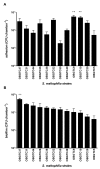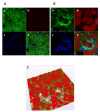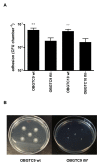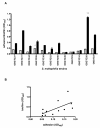Adhesion to and biofilm formation on IB3-1 bronchial cells by Stenotrophomonas maltophilia isolates from cystic fibrosis patients
- PMID: 20374629
- PMCID: PMC2858031
- DOI: 10.1186/1471-2180-10-102
Adhesion to and biofilm formation on IB3-1 bronchial cells by Stenotrophomonas maltophilia isolates from cystic fibrosis patients
Abstract
Background: Stenotrophomonas maltophilia has recently gained considerable attention as an important emerging pathogen in cystic fibrosis (CF) patients. However, the role of this microorganism in the pathophysiology of CF lung disease remains largely unexplored. In the present study for the first time we assessed the ability of S. maltophilia CF isolates to adhere to and form biofilm in experimental infection experiments using the CF-derived bronchial epithelial IB3-1cell line. The role of flagella on the adhesiveness of S. maltophilia to IB3-1 cell monolayers was also assessed by using fliI mutant derivative strains.
Results: All S. maltophilia CF isolates tested in the present study were able, although at different levels, to adhere to and form biofilm on IB3-1 cell monolayers. Scanning electron and confocal microscopy revealed S. maltophilia structures typical of biofilm formation on bronchial IB3-1 cells. The loss of flagella significantly (P < 0.001) decreased bacterial adhesiveness, if compared to that of their parental flagellated strains. S. maltophilia CF isolates were also able to invade IB3-1 cells, albeit at a very low level (internalization rate ranged from 0.01 to 4.94%). Pre-exposure of IB3-1 cells to P. aeruginosa PAO1 significantly increased S. maltophilia adhesiveness. Further, the presence of S. maltophilia negatively influenced P. aeruginosa PAO1 adhesiveness.
Conclusions: The main contribution of the present study is the finding that S. maltophilia is able to form biofilm on and invade CF-derived IB3-1 bronchial epithelial cells, thus posing a rationale for the persistence and the systemic spread of this opportunistic pathogen in CF patients. Experiments using in vivo models which more closely mimic CF pulmonary tissues will certainly be needed to validate the relevance of our results.
Figures






Similar articles
-
Phenotypic and genotypic characterization of Stenotrophomonas maltophilia isolates from patients with cystic fibrosis: genome diversity, biofilm formation, and virulence.BMC Microbiol. 2011 Jul 5;11:159. doi: 10.1186/1471-2180-11-159. BMC Microbiol. 2011. PMID: 21729271 Free PMC article.
-
Molecular characterization of virulence determinants of Stenotrophomonas maltophilia strains isolated from patients affected by cystic fibrosis.Int J Immunopathol Pharmacol. 2007 Jul-Sep;20(3):529-37. doi: 10.1177/039463200702000311. Int J Immunopathol Pharmacol. 2007. PMID: 17880766
-
Genotypic and Phenotypic Characterization of Stenotrophomonas maltophilia Strains from a Pediatric Tertiary Care Hospital in Serbia.PLoS One. 2016 Oct 31;11(10):e0165660. doi: 10.1371/journal.pone.0165660. eCollection 2016. PLoS One. 2016. PMID: 27798695 Free PMC article.
-
Stenotrophomonas maltophilia biofilm: its role in infectious diseases.Expert Rev Anti Infect Ther. 2019 Nov;17(11):877-893. doi: 10.1080/14787210.2019.1685875. Epub 2019 Nov 1. Expert Rev Anti Infect Ther. 2019. PMID: 31658838 Review.
-
Stenotrophomonas maltophilia: to be or not to be a cystic fibrosis pathogen.Curr Opin Pulm Med. 2012 Nov;18(6):628-31. doi: 10.1097/MCP.0b013e328358d4f8. Curr Opin Pulm Med. 2012. PMID: 22990659 Review.
Cited by
-
Stenotrophomonas maltophilia virulence and specific variations in trace elements during acute lung infection: implications in cystic fibrosis.PLoS One. 2014 Feb 28;9(2):e88769. doi: 10.1371/journal.pone.0088769. eCollection 2014. PLoS One. 2014. PMID: 24586389 Free PMC article.
-
Update on infections caused by Stenotrophomonas maltophilia with particular attention to resistance mechanisms and therapeutic options.Front Microbiol. 2015 Sep 2;6:893. doi: 10.3389/fmicb.2015.00893. eCollection 2015. Front Microbiol. 2015. PMID: 26388847 Free PMC article. Review.
-
Enhanced suppression of Stenotrophomonas maltophilia by a three-phage cocktail: genomic insights and kinetic profiling.Antimicrob Agents Chemother. 2025 Mar 5;69(3):e0116224. doi: 10.1128/aac.01162-24. Epub 2025 Jan 22. Antimicrob Agents Chemother. 2025. PMID: 39840957 Free PMC article.
-
Biofilm compared to conventional antimicrobial susceptibility of Stenotrophomonas maltophilia Isolates from cystic fibrosis patients.Antimicrob Agents Chemother. 2013 Mar;57(3):1546-8. doi: 10.1128/AAC.02215-12. Epub 2013 Jan 7. Antimicrob Agents Chemother. 2013. PMID: 23295930 Free PMC article.
-
Genome-wide analysis reveals the emergence of multidrug resistant Stenotrophomonas acidaminiphila strain SINDOREI isolated from a patient with sepsis.Front Microbiol. 2022 Sep 23;13:989259. doi: 10.3389/fmicb.2022.989259. eCollection 2022. Front Microbiol. 2022. PMID: 36212813 Free PMC article.
References
Publication types
MeSH terms
Substances
LinkOut - more resources
Full Text Sources
Medical

